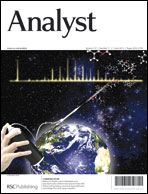Quantification of Cry1Ab in genetically modified maize leaves by liquid chromatography multiple reaction monitoring tandem mass spectrometry using 18O stable isotope dilution
Abstract
Cry1Ab is one of the most common Bacillus thuringiensis (Bt) proteins in genetically modified crops, which exhibits strong resistance against insect pests. In the present study, a sensitive and precise liquid chromatography stable isotope dilution multiple reaction monitoring tandem mass spectrometry (LC-SID-MRM-MS) assay was developed and validated to quantify the amount of Cry1Ab expression in transgenic maize leaves. The measurement of protein was converted to measurement of unique peptides to Cry1Ab protein. Two peptides unique to Cry1Ab were synthesized and labeled in H218O to generate 18O stable isotope peptides as internal standards. The validated method obtained superior specificity and good linearity. And the inter- and intra-day precision and accuracy for all samples were satisfactory. The results demonstrated Cry1Ab protein was 31.7 ± 4.1 μg g−1 dry weight in Bt-176 transgenic maize leaves. It proved that the novel LC-SID-MRM-MS method was sensitive and selective to quantify Cry1Ab in the crude extract without time-consuming pre-separation or purification procedures.


 Please wait while we load your content...
Please wait while we load your content...